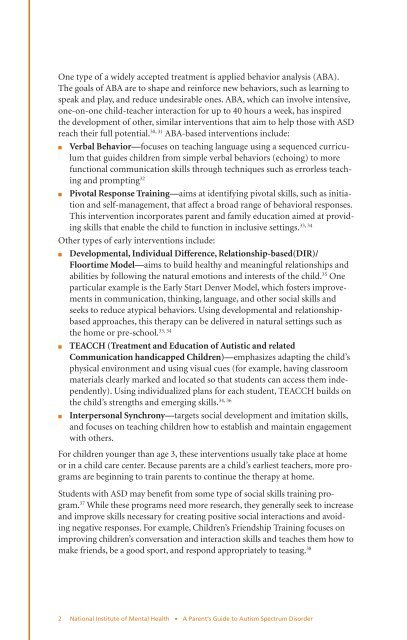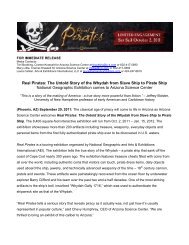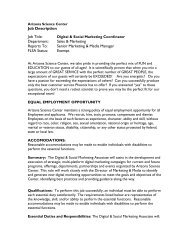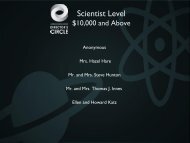A Parent's Guide to Autism Spectrum Disorder - NIMH - National ...
A Parent's Guide to Autism Spectrum Disorder - NIMH - National ...
A Parent's Guide to Autism Spectrum Disorder - NIMH - National ...
Create successful ePaper yourself
Turn your PDF publications into a flip-book with our unique Google optimized e-Paper software.
One type of a widely accepted treatment is applied behavior analysis (ABA).<br />
The goals of ABA are <strong>to</strong> shape and reinforce new behaviors, such as learning <strong>to</strong><br />
speak and play, and reduce undesirable ones. ABA, which can involve intensive,<br />
one-on-one child-teacher interaction for up <strong>to</strong> 40 hours a week, has inspired<br />
the development of other, similar interventions that aim <strong>to</strong> help those with ASD<br />
reach their full potential. 30, 31 ABA-based interventions include:<br />
n Verbal Behavior—focuses on teaching language using a sequenced curriculum<br />
that guides children from simple verbal behaviors (echoing) <strong>to</strong> more<br />
functional communication skills through techniques such as errorless teaching<br />
and prompting 32<br />
n Pivotal Response Training—aims at identifying pivotal skills, such as initiation<br />
and self-management, that affect a broad range of behavioral responses.<br />
This intervention incorporates parent and family education aimed at providing<br />
skills that enable the child <strong>to</strong> function in inclusive settings.<br />
33, 34<br />
Other types of early interventions include:<br />
n<br />
n<br />
n<br />
Developmental, Individual Difference, Relationship-based(DIR)/<br />
Floortime Model—aims <strong>to</strong> build healthy and meaningful relationships and<br />
abilities by following the natural emotions and interests of the child. 35 One<br />
particular example is the Early Start Denver Model, which fosters improvements<br />
in communication, thinking, language, and other social skills and<br />
seeks <strong>to</strong> reduce atypical behaviors. Using developmental and relationshipbased<br />
approaches, this therapy can be delivered in natural settings such as<br />
33, 34<br />
the home or pre-school.<br />
TEACCH (Treatment and Education of Autistic and related<br />
Communication handicapped Children)—emphasizes adapting the child’s<br />
physical environment and using visual cues (for example, having classroom<br />
materials clearly marked and located so that students can access them independently).<br />
Using individualized plans for each student, TEACCH builds on<br />
34, 36<br />
the child’s strengths and emerging skills.<br />
Interpersonal Synchrony—targets social development and imitation skills,<br />
and focuses on teaching children how <strong>to</strong> establish and maintain engagement<br />
with others.<br />
For children younger than age 3, these interventions usually take place at home<br />
or in a child care center. Because parents are a child’s earliest teachers, more programs<br />
are beginning <strong>to</strong> train parents <strong>to</strong> continue the therapy at home.<br />
Students with ASD may benefit from some type of social skills training program.<br />
37 While these programs need more research, they generally seek <strong>to</strong> increase<br />
and improve skills necessary for creating positive social interactions and avoiding<br />
negative responses. For example, Children’s Friendship Training focuses on<br />
improving children’s conversation and interaction skills and teaches them how <strong>to</strong><br />
make friends, be a good sport, and respond appropriately <strong>to</strong> teasing. 38<br />
2 <strong>National</strong> Institute of Mental Health • A Parent’s <strong>Guide</strong> <strong>to</strong> <strong>Autism</strong> <strong>Spectrum</strong> <strong>Disorder</strong>









